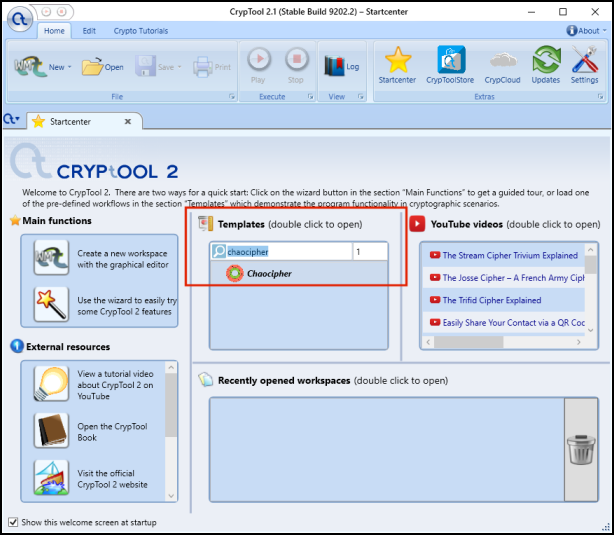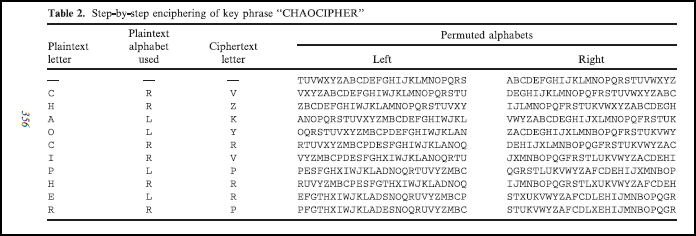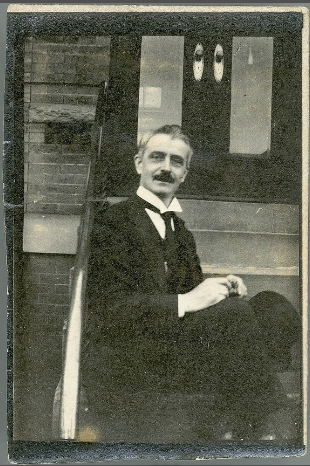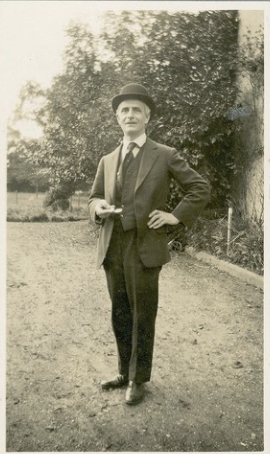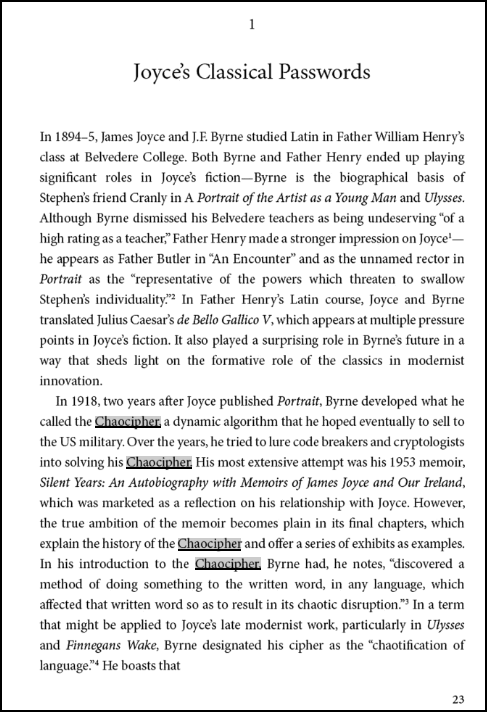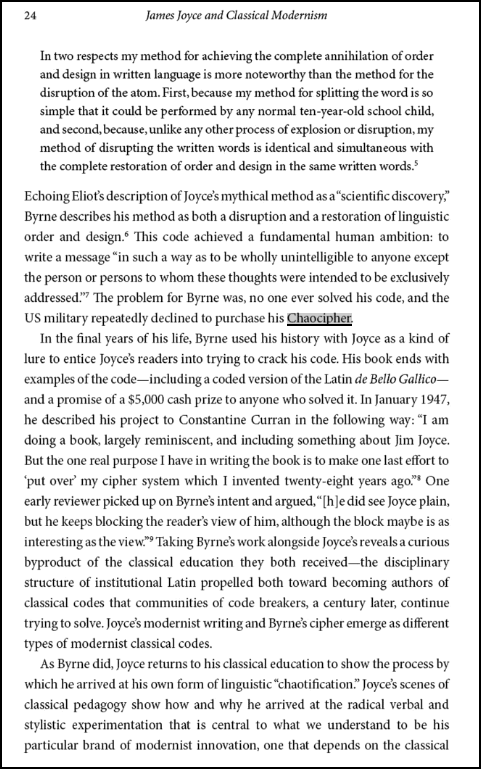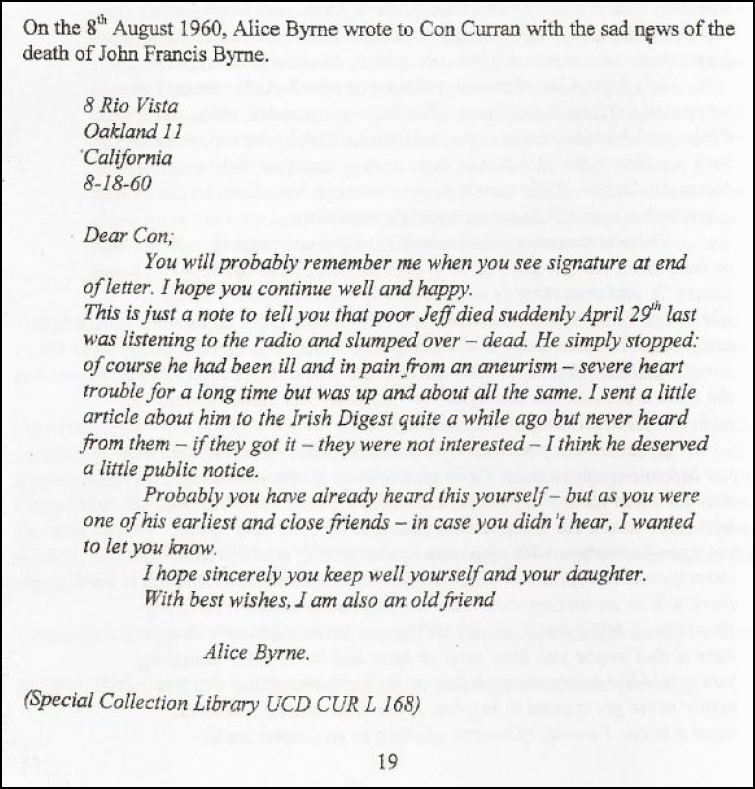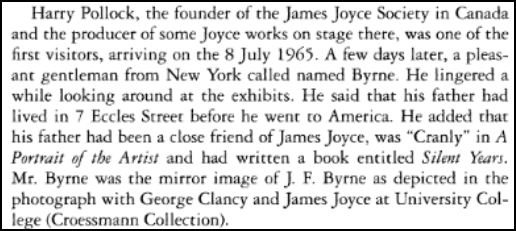The Chaocipher Clearing
House
Progress Report #28
12 January 2023
This Progress Report is a compilation of Chaocipher-related
information since Progress
Report #27 (August 2020).
Here's a brief listing of items:
Chaocipher and Cryptology
Literary History (John F. Byrne, James Joyce)
Chaocipher and Cryptology
My ICCH (International Conference of Cryptologic History) presentation: "The Hunt for Chaocipher"
On 8 August 2021 I gave a WebEx-based presentation entitled "The Hunt for Chaocipher" to the members of the International Conference of Cryptologic History (ICCH). In the ICCH's own words:
The International
Conference on Cryptologic History (ICCH) is a forum for the discussion
of cryptologic history. Established in 2004 as 'Crypto Collectors', the
group includes members located in many countries around the world.
Every few weeks another member presents a web-based lecture on a
cryptologic topic. I have found ICCH members to be knowledgeable,
interesting, and friendly.
My presentation lasted 1 hour 38 minutes, including Q&A following the presentation (cached).
Several Chaocipher-related posts by Mark VandeWettering on his brainwagon.org blog
Mark VanderWettering is the maintainer of a nifty blog called "brainwagon". Mark jumped on the Chaocipher wagon (pun kind of intended :-)) a few days after I uploaded the first document that revealed how Chaocipher worked. Over the next week, Mark authored several post related to Chaocipher:
They make interesting reading. You can access them with the following query link.
Smith & Lewis submit new cipher scheme
Between January and April of 1954, John F. Byrne attempted to
commercialize Chaocipher, and turned to two engineers, Howard N. Smith
and Howard W. Lewis, who were employed at Standard Oil, as
potential marketers. You can read John Byrne's (the son) letter to his father
about having met the two engineers, and subsequent correspondences
between John F. Byrne and Smith & Lewis can be found on the historical correspondence webpage. It seems that nothing came out of that interaction.
It is therefore of interest to find, on the NSA website, that in
November 1954, Smith and Lewis submitted a cipher system of their own
to the NSA. The document (cached here), written on 14 November 1954, uses terms highly reminiscent of Chaocipher as the basis of their cipher invention (pages 1-2).:
In order to
describe the cipher, it will first be necessary to describe a simple
device which can be used to illustrate the procedures for enciphering
and deciphering messages. This device consists of two gears which have
twenty-six teeth each or one tooth for each letter of the alphabet. The
teeth on each gear are marked from "A" to "Z" in a clockwise direction.
One of these gears is called the "message wheel" and the other is
called the "cipher wheel" The wheels are free to rotate when engaged,
and the cipher wheel can be disengaged from the message wheel, rotated
or "indexed" from one to twenty-six teeth in a clockwise direction, and
then re-engaged with the message wheel. Thus there are twenty-six
possible engagements or the wheels. There are two fixed reference
points, one for each wheel, which indicate the message-cipher
relationship between the letters on the two wheels. This relationship
is fixed for each engagement, and is different for each of the
twenty-six possible engagements.
The document is somewhat long-winded, possibly expected for one written by people unschooled in the art of cryptanalysis.
On 21 March 1955, Major General Frank E. Stoner personally submitted
Smith and Lewis's cipher proposal to William F. Friedman. In the related correspondences found on the NSA website (cached here),
we read how, on 1 April 1955, Friedman passed the task of investigating
their cipher proposal to Col. F. E. Horrelko (USAF). Col.
Horrelko responded on 18 April 1955 that:
The system
described in the brochure inclosed with the reference has been examined
and found to incorporate no principles which are superior to those
presently in use. It is a type of autokey (Vigenere) substitution
wherein each key value is determined by the random selection of a
letter, conversion of that letter to a displacement interval by a mixed
canponent, and the corresponding displacement of the plain and cipher
components from their preceeding aligrnnent. Alternate letters of the
cipher are the encipherment of the randomly-selected (indicator)
letters.
It is not known whether Byrne knew of this proposal made by Smith and
Lewis, and one can only imagine what his reaction might have been
had he found out.
CrypTool2 supports a Chaocipher visualizer
The CrypTool 2 open-source project is a boon for students of cryptography. Here's how it describes itself:
CrypTool 2 (CT2) is
a modern e-learning program for Windows, which visualizes cryptography
and cryptanalysis. It includes not only the encryption and
cryptanalysis of ciphers, but also their basics and the whole spectrum
of modern cryptography.
CT contains over 200 ready-to-use templates with workflows. You can
also easily combine and execute cryptographic functions to create
workflows in CT2 by yourself (visual programming). With this approach,
complex processes can be easily visualized and thus better understood.
CrypTool 2 provides many built-in functions that implement a plethora
of cryptographic processes, and that includes functionality for
implementing a Chaocipher system.
Once you've installed CrypTool 2, you can fire up a session, then search for "chaocipher" in the templates search control:
Double-clicking the "chaocipher" template option opens a pre-written, ready-to-run Chaocipher implementation:
Take it out for a spin - the results will get you thinking of other uses for CrypTool 2.
Here are some other resources that will help:
If you're a developer or an educator, you will find this product of interest.
Near impossibility of solving Chaocipher without system knowledge
In 2020, the NSA declassified the third book of its awesome trilogy "Military Cryptanalytics". This series, written byWilliam F. Friedman and his esteemed NSA cryptologist and protege Lambros D. Callimahos,
finally revealed most of the cryptanalytic theory and techniques for
tackling classic ciphers (tantalizing portions are still redacted for
security reasons).
This event elicited an article by Richard Bean, entitled "Declassified Cold War code-breaking manual has lessons for solving ‘impossible’ puzzles" and published on The Conversation website.
Our interest in this article, besides its inttiguing premise, is its highlighting Chaocipher as a
This means you may
have to eventually reveal the method you used. One example is a complex
algorithm known as Chaocipher. While Chaocipher messages were designed
to be highly difficult, they’re virtually impossible to decipher
without knowing the method.
Looks like Chaocipher has made it to the big times <g>.
Chaocipher mentioned in "Uncracked Codes and Ciphers" (Ann Byers, 2017)
In "Uncracked Codes and Ciphers" by Ann Byers (2017), we find an intelligent summary
of the history of Chaocipher indecipherability. Byers notes that
Byrne's Chaocipger papers were donated to the National Cryptologic
Museum in 2012, and that the cipher secret was revealed. However,
she continues, it is not clear whether "the
messages would be "absolutely indecipherable" by anyone except the
intended recipients? Cryptographers are still working to see if
that is true."
YouTube video "Most DIFFICULT Codes That Were Ever CRACKED!" presents balanced description of Chaocipher
You can watch an intelligent description of Chaocipher in a YouTube video entitled "Most DIFFICULT Codes That Were Ever CRACKED!". The relevant portion begins at time 8:38 and leasts for 1:11 minutes.
A 2019 Reddit thread entitled "Improving Chaocipher"
A 2019 Reddit thread entitled "Improving Chaocipher"
raises interesting points. some that have been known
to Chaocipher circles. Much of the thread is based on PR
Ruiz's blog "The Scrabble Cipher".
yamhill_pub wishes to improve
Chaocipher by making the scrambling of the left and right
wheels/alphabets after each encipherment part of the key. Byrne's
original scheme permutes the alphabets using the following Python-like
slicing:
CT scramble: [0:1] [2:14] [1:2] [14:26]
PT scramble: [1:3] [4:15] [3:4] [15:26] [0:1]
Proposes to make the permuting slices part of the key. So, for example, the permutation might be:
CT scramble: [0:1] [2:11] [1:2] [19:26] [14:19]
PT scramble: [1:3] [4:13] [3:4] [15:26] [0:1] [13:15]
Another topic mentioned is that Chaocipher is susceptible to
enciphering a plaintext consisting of only one letter (e.g., all 'A's).
Mention is made to:
- Beginning with straight A-Z plaintext and ciphertext alphabets
- Appending N (N>=20) random letters to the starting plaintext
- Enciphering using the Chaocipher algorithm
- Removing the first N latters of the ciphertext
- Sharing the N letters with the receiver
It turns out the Byrne used a related method to generate mixed left and right alphabets:
In this example, Byrne chose the keying phrase "CHAOCIPHER".
Beginning with straight A-Z alphabet for both the left and right
alphabets, and given a key as to which alphabet would be the plaintext
alphabet ("RRLLRRLRLR - right/right/left/left/... etc."), the alphabets
are primed by enciphering the keying phrase. Once
enciphered, the remaining alphabets are the starting ones. This
is echoed by the Reddit poster "LolThisGuyAgain".
In the Reddit thread, as well in PR Puiz's blog, they recommend
enciphering 20 random characters on left/right straight alphabets, then
sharing these 20 random "plaintext" letters with the receiver via a
different channel.
The CipherBrain blog presents a Chaocipher-like challenge: Christoph’s Chaotic Caesar Challenge
Claus Schmeh's CipherBrain blog
is a fascinating website that features a continuous stream of real-life
classical cryptographic puzzles and challenges (some pages are in
German, just translate with Google Translate).
In May 2020 a column entitled "Christoph’s Chaotic Caesar Challenge"
was presented, in which contributor Christoph Tenzer challenge readers
to solve a cipher message using a cipher system of his creation.
Actually, Christoph's cipher system is a stripped-down version of
Chaocipher. Here is how Schmeh describe's Christoph's system:
In
the following, we work with the standard English 26-letter alphabet. We
need a keyword and a number n. As an example, we take the keyword
CHALLENGE and n=3. The keyword is used to rearrange the alphabet in the
usual way: Write the keyword first, omit repeating letters, append the
remaining letters. For CHALLENGE, we receive:
CHALENGBDFIJKMOPQRSTUVWXYZ
To
encrypt a plaintext, one starts with the first letter and performs the
following steps (in the first step, the number n comes into play):
- Find
the position of the plaintext letter in the cipher alphabet. The
ciphertext letter is the one n steps to the right (continue counting
from the left if you reach the end).
- Switch the position of plaintext and ciphertext letter in the cipher alphabet.
- Continue with the next plaintext letter.
Using the keyword CHALLENGE and n=3, the plaintext TO BE OR NOT TO BE is encrypted as follows:
T returns W and then the positions of T and W are switched, so the alphabet is now: CHALENGBDFIJKMOPQRSWUVTXYZ
O returns R and then the positions of O and R are switched, and the alphabet is now: CHALENGBDFIJKMRPQOSWUVTXYZ
B returns I and then the positions of B and I are switched, and the alphabet is now: CHALENGIDFBJKMRPQOSWUVTXYZ
E returns I and so on ...
Here’s the ciphertext: WRIIUUDXZACMM
The cipher uses Chaocipher's concept of dynamic substitution, this time on a single alphabet.
What
TCCH readers will find of interest is the number of high-profile
cryptanalysts (e.g., George Lasry, David Oranchak) that weighed in on
this challenge, and the discussion that follows on how they solved this
and another challenge message.
Literary History (John F. Byrne, James Joyce)
Glenn Johnston's photos of John F. Byrne's places of residence
In August 2020 I received an email from Glenn Johnston, in which he wrote:
I am very interested in John F. Byrne as a result of a passion for James
Joyce, and have found it to be a great resource. I have visited Byrne's
New York addresses as identified in the Chaocipher letters and have
attached pictures of 2069 Nostrand Avenue, 1114 New York Avenue, and
1647 Macombs Rd. (The Wilson St. and Long Island City buildings have
been replaced.)
Glenn kindly provide TCCH with high-resolution photographs of three of
the buildings that John F. Byrne had resided in. You can see the
images here:
Two photos of John F. Byrne, available on the UCD (University College Dublin) Digital Library website
The Cryptologia paper "John F. Byrne's Chaocipher Revealed: An Historical and Technical Appraisal" (October 2011) presented two photographs of John F. Byrne on page 340:
These photos, originally from the Constantine Peter Curran photographic
collection, now resides in the UCD (University College Dublin) Digital
Library. Click on either photograph to link to the respective UCD
webpage.
The introductory letter sent to Patricia Byrne after locating her
As told over elsewhere on this website,
Patricia Byrne, John Byrne's wife and John F. Byrne's daughter-in-law,
was located by cold-calling telephone numbers belonging to people named
Byrne in the state of Vermont in the United States. On 9 August
2009 I fortuitously called Patricia Byrne. Pat Byrne was then
almost 90 years old, in frail health, and she wanted to know who I was
and what my interest in Chaocipher was. In the conversation she
gave me her post office box address, which enabled me to send her a
well-thought out postal letter addressing her suspicions.
I spent the next few weeks investigating the best course of action for
her, with a view to enabling her to patent Chaocipher before opening it
up to the computer world for evaluation. Once I had investigated
the options, I wrote her a personal letter presenting the options.
You can read this initial letter to Pat Byrne here.
Byrne and Chaocipher mentioned in Leah Culligan Flack's "James Joyce and Classical Modernism"
Leah Culligan Flack's book "James Joyce and Classical Modernism (Classical Receptions in Twentieth-Century Writing)" contains several Chaocipher-related passages. Here they are for the record:
"The So Called Real Person Who Lived at No.7 Eccles St." (by Elaine Byrne)
Elaine Byrne, a
resident of Wicklow County in Ireland, has authored an
extended and informative article on the close relationship between
James Joyce and Wicklow man, John Francis Byrne, who was a distant
relative of Elaine The article, entitled "The So Called Real Person Who Lived at No.7 Eccles St", fleshes out so many passages found in Byrne's
autobiographical "Silent Years", adding invaluable information for
those who are fascinated by the biographies of Byrne and Joyce.
The paper adds so much new information pertaining to Byrne's
roots in Wicklow.
The paper can be found in Wicklow Roots, The Wicklow County Genealogical Society Journal, No. 9
(2004),
published by Wicklow County Genealogical Society, Wicklow Town,
Co. Wicklow, Ireland. The introduction and the genealogical notes
on the Byrne Family were added by the editor of the journal, the late
Declan Byrne.
John F. Byrne's entry in the Dictionary of Irish Biography
The online Dictionary of Irish Biography carries a page dedicated to John Francis Byrne.
John F. Byrne's official date of death
Until Elaine Byrne shared her "The So Called Person Who Lived at No.7 Eccles St."
(see the previous item on this page), I knew that John F. Byrne
was born on 11 February 1880, but was only aware that his date of death
was in the year 1960. Nowhere has I come across an obituary or
other source that told us his full date of death.
Even the scholarly Dictionary of Irish Biography lists his full date of birth, but mentions only his year of death.
On page 19 of Elaine Byrne's excellent work we find the following letter sent by Byrne's first wife, Alice (Headen) Byrne to Constantine Peter Curran (1883-1972), a lawyer and historian of 18th Century Dublin architecture, sculpture and plasterwork.
Now we know Byrne's full date of death: 29 April 1960.
Two book reviews of John F. Byrne's "Silent Years":
- The May 1954 issue of "America: A Catholic Review of the Week"
- The Catholic Renascence Society's Spring 1956 issue of "Renascence", page 152.
"The Cryptogram In Joyce’s Ulysses: A Misprint" (Publications
of the Modern Language Association of America (PMLA) , September 1958)
In Ulysses, Leopold Bloom’s locked private drawer at 7 Eccles Street contains, among other things:
3 typewritten
letters, addressee, Henry Flower, c/o P.O. Westland Row, addresser,
Martha Clifford, c/o P.O. Dolphin’s Barn: the transliterated name
and address of the addresser of the 3 letters in reversed alphabetic
boustrophedontic punctated quadrilinear cryptogram (vowels suppressed)
N. IGS./WI. UU. OX/W. OKS. MH/Y. IM …
As David Kahn writes (The Codebreakers, page 767, in the footnote):
It may not be coincidence that in
Ulysses
an inventory of Mr. Leopold Bloom's locked private drawer at 7 Eccles
Street included among other things "3 typewritten letters, addressee,
Henry Flower, c/o P.O. Westland Row, addresser, Martha Clifford, c/o
P.O. Dolphin’s Barn: the transliterated name and address of the
addresser of the 3 letters in reversed alphabetic boustrophedontic
punctated quadrilinear cryptogram (vowels suppressed) N. IGS./WI. UU.
OX/W. OKS. MH/Y. IM …" "Quadrilinear" meant to set the
cipher in four lines; "reversed alphabetic" indicated the key of
a = Z,
b = Y,
etc.; "boustrophodontic," and adjective concocted from the adjective
"boustrephodon,", a technical term in paleography referring to writing
that runs left and right in alternate lines, indicating that the lines
of the cryptogram were to be read in that way. Unfortunately,
Joyce or Bloom forgot about this in the fourth line, which incorrectly
reads left to right. The cryptogram and its solution thus are:
N . I G S .
m a r t h a
W I . U U . O X
d r o f f i l c
W . O K S . M H
d o l p h i n s
Y . I M
b a r n
In the Publications of the Modern Language Association of America
(PMLA), 1958-09: Vol 73 Issue 4 (pages 446-447), you can find an
interesting article entitled "The Cryptogram in Joyce's "Ulysses": a Misprint", written by Grover Smith, Jr. of Duhe University, which discusses errors in later editions of Ulysses.
Smith notes the following:
As one might suspect upon examining the
description and as one learns upon comparing early editions of Ulysses,
Joyce did not write "reserved alphabetic," which means nothing; he
wrote "reversed alphabetic." Unlike neighboring corruptions in the
text, the misprint
reserved has obscured the sense and has prompted erroneous interpretation. For example,
Stuart Gilbert, supposing that
reserved concealed 'a secret name,' has imagined that "the clue to this reservation may be found in the Black Mass of
Circe."
Anyone in possession of Joyce’s original phrase can decipher
Bloom’s memorandum without any such cross reference, the purport
of which remains mysterious.
I bring this item because of footnote number 3 in Smith's article on page 446, which reads:
[3] Ibid. J. F. Byrne, in Silent Years:
An Autobiography with Memoirs of James Joyce and Our Ireland (New York:
Farrar, Straus and Young, 1953), pp. 161-162. calls
Gilbert’s comment “‘odd” and concludes that he
is “floundering.” Byrne seems thus unaware of the misprint.
Byrne, the model for Cranly in Joyce’s Portrait of the Artist as
a Young Man, lived at No. 7 Eccles Street from 1908 to 1910. In 1918 he
himself invented a ciphering system called “Chaocipher”
(Silent Years, pp. 264-307).
Here's what Byrne wrote in "Silent Years" (pages 161-162):
In that paragraph wherein are detailed
the contents of "the first drawer unlocked" there is this item: "the
transliterated name and address of the addresser of the 3 letters in
reversed alphabetic boustrephodontic punctuated quadrilinear cryptogram
(vowels suppressed) N.IGS./WI.UU.OX/W.OKS.MH/Y.IM"
That the long word "boustrephodontic" is misspealled is of no
consequence: but Mr. Gilbert's reference to this cryptogram is odd.
He says of it in a footnote: "The second word, a secret name, is
'reserved'; the clue to this reservation may be found in the Black Mass
of Circe. Here one
could charitably suppose that Mr. Gilbert's use of the word
"reserved" was a slip of the pen, but when he goes on to amplify his
remark by reference to "this reservation"; and when he says vaguely
where the "clue may be found" he is clearly floundering."
It is obvious that Byrne was quoting the correct original edition of
Ulysses, where the phrase used was "reversed alphabetic", and not
"reserved alphabetic". Smith's point is that Byrne was not aware
of corruptions in later editions, and therefore was impatient with
Gilbert's "odd" and "floundering" interpretations.
The lesson here is that researchers should always check the first
edition of a book they are critipuing to guarantee they are not
building on a corruption.
The Harvey Breit Correspondence collection features two letters from 1952
Harvey Breit
was an American poet, editor, and playwright as well as reviewer for
The New York Times Book Review from 1943 to 1957. His connection
to John F. Byrne is two-fold: "Silent Years" is dedicated to
Harvey Breit, and Breit wrote the foreword in "Silent Years.
The Briet's correspondences are located in the Harvey Breit Correspondence,
1940-1965, Manuscript Series I, Charles Deering McCormick Library of
Special Collections, Northwestern University Library. The
collection contains two letters sent between them.
John Byrne (the son) sighted at the James Joyce Tower and Museum in 1965
In the article "Early Joyceans in Dublin", written by Vivien Veale Igoe and published in the periodical Joyce Studies Annual,
Volume 12, Summer, we find an interesting Byrne-related anecdote.
On page 84 we read about Harry Pollock, the founder of the James
Joyce Society in Canada, meeting John Byrne, the son of John F. Byrne:
The meeting took place in the James Joyce Tower and Museum in Sandycove, Dublin.
John Byrne (the son) Social Security information

National Library of Ireland (NLI) has ten (1) letters related to John Francis Byrne
The National Library of Ireland (NLI) has ten (10) letters related to John Francis Byrne
in their possession. Most of the letters are his correspondences
with Francis Sheehy Skeffington, but the last item may hold interesting
biographical information about Byrne:
| Main Creator |
Lyng, John J. |
| Contributors |
O'Brien, William, 1881-1968 |
| Summary |
Lyng quotes a passage from Byrne's book, describes some of his life and
notes that he wrote under the pseudonym "Renby - an anagram of Byrne". |
| In collection |
William O'Brien (1881-1968) Papers, 1898-1969 |
| Format |
Manuscript |
| Language |
English |
| Subjects |
Lyng, John J. > Correspondence
O'Brien, William, > 1881-1968 > Correspondence
Connolly, James, > 1868-1916
Byrne, John Francis, > 1880-1960
United States > History > 20th century |
| Notes |
Includes annotations by O'Brien of page numbers and the date he replied "2/12/61". |
| Physical description |
1 item (1 page) |
| Arrangement |
Item |
Here are the bits from the last item relevant to Byrne:
Dear Bill, - The following quotation
from “Silent Years” may be new to you.
Page 112 “The head & front of the
immediate active group was James Connolly … He was about 40 yrs
old, stocky build, earnest, bullet headed, & determined to the
degree of obstinacy. He spoke with a pronounced accent which might
be North of Ireland, but seemed to me like Scotch.” Page 112 –
“Silent Years” by John Francis Byrne, First printing, 1955 in New
York by Farras, Straus & Young.
J. F. Byrne worked as a financial
writer for the Fairchild Publications under the pen name of J. F.
Renby. He stayed5 or 6 years & was eased out during the
depression about 1933 after F.D.R. became Pres., U.S.A. I spent 30
yrs. With the same firm. I only knew that Renby was a Dublin man,
but never tried to contact him as the firm was averse to “Union
men” trying to spread their ideas with the unorganized “Brain
Trust”. However, they were later organized by the Newswriter’s
Guild, sponsored by Heywood Broun, a columnist of the now defunct,
N.Y. World.
[...]
J. F. Byrne lived at 7 Eccles St. in
the vicinity of 43 Belvidere Place & you probably met him with
Joyce, while he stayed there.
Hoping you and Cissy are well and able
to keep moving as all here are fairly comfortable.
Fraternally,
John J. Lyng
P.S. RENBY – is an “Anagram of
Byrne”
Bruce Pandolfini, the chess master and teacher, mentions John F. Byrne
Bruce Pandolfini
is an American chess author, teacher, and coach, and is generally
considered to be America's most experienced chess teachers.
In 1988, Pandolfini was featured in Fred Waitzkin's book "Searching for
Bobby Fischer" (1988), a perceptive narrative on his talented son Josh
and Josh's successes in the world of children's chess. The book later
(in 1992) became a Paramount Pictures film of the same title, in which
Pandolfini, Josh’s real-life teacher, was portrayed by
award-winning actor Ben Kingsley.
Pandolfini was a consultant to The Queen's Gambit, a 2020 American
Netflix miniseries, where he also had a cameo role as a tournament
director. He had also been a consultant to the original 1983 novel, for
which he suggested the title.
His connection to Chaocipher can be seen in one of his his 2001 web-based columns entitled "The Q&A Way":
Question
In reading one of your past answers it seemed that you might know
something about James Joyce and Samuel Beckett as chess players.
Somewhere I heard that Joyce and Beckett both played chess. Do you know
anything about this? Warren Anderson (USA)
Answer From the little I know
Joyce didn’t play chess at all, and though he made several
inscrutable references to chess in Finnegan’s Wake, it appears
that he actually detested the game and its passionate adherents. I
recall some story about his association with J. F. Byrne, an avid
chessplayer and owner of 7 Eccles Street, the house where Leopold Bloom
“ate with relish the inner organs of beasts and fowls.”
Apparently Joyce would meet Byrne at a local pub, which happened to
contain a few chess tables. Since Byrne was invariably playing chess,
Joyce would have to sit idly by until the session’s completion,
no matter how long it took, and there’s no evidence that Joyce
ever had an epiphany to participate.
Copyright
(c) 2023 Moshe Rubin
Created: 12 January 2023
Last Updated: 27 January 2024
